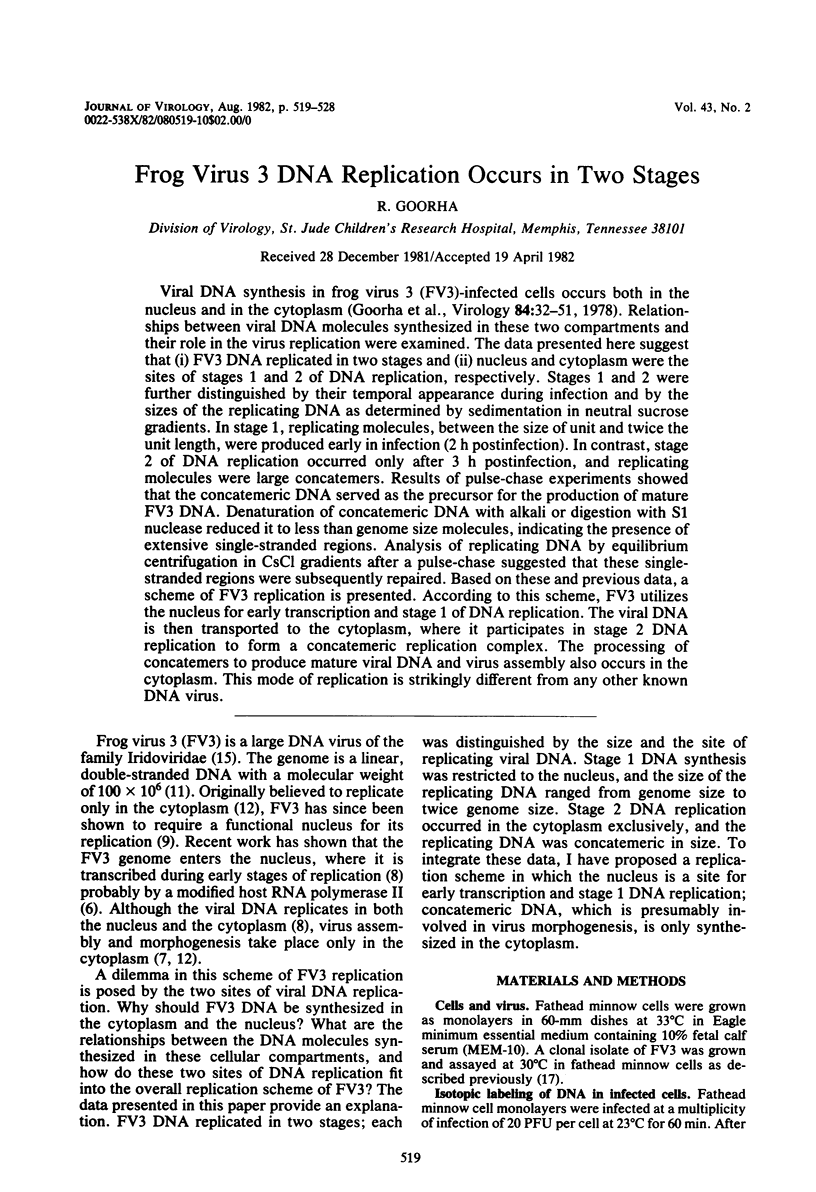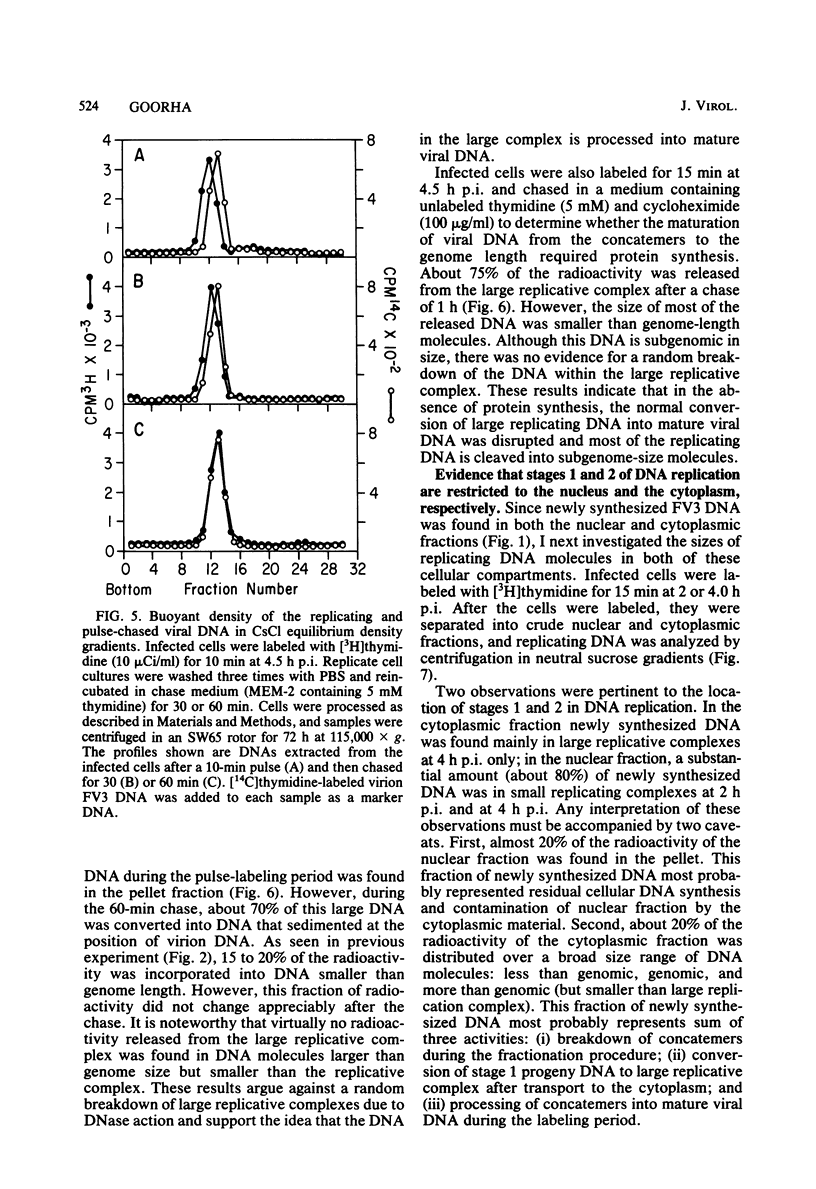Abstract
Viral DNA synthesis in frog virus 3 (FV3)-infected cells occurs both in the nucleus and in the cytoplasm (Goorha et al., Virology 84:32-51, 1978). Relationships between viral DNA molecules synthesized in these two compartments and their role in the virus replication were examined. The data presented here suggest that (i) FV3 DNA replicated in two stages and (ii) nucleus and cytoplasm were the sites of stages 1 and 2 of DNA replication, respectively. Stages 1 and 2 were further distinguished by their temporal appearance during infection and by the sizes of the replicating DNA as determined by sedimentation in neutral sucrose gradients. In stage 1, replicating molecules, between the size of unit and twice the unit length, were produced early in infection (2 h postinfection). In contrast, stage 2 of DNA replication occurred only after 3 h postinfection, and replicating molecules were large concatemers. Results of pulse-chase experiments showed that the concatemeric DNA served as the precursor for the production of mature FV3 DNA. Denaturation of concatemeric DNA with alkali or digestion with S1 nuclease reduced it to less than genome size molecules, indicating the presence of extensive single-stranded regions. Analysis of replicating DNA by equilibrium centrifugation in CsCl gradients after a pulse-chase suggested that these single-stranded regions were subsequently repaired. Based on these and previous data, a scheme of FV3 replication is presented. According to this scheme, FV3 utilizes the nucleus for early transcription and stage 1 of DNA replication. The viral DNA is then transported to the cytoplasm, where it participates in stage 2 DNA replication to form a concatemeric replication complex. The processing of concatemers to produce mature viral DNA and virus assembly also occurs in the cytoplasm. This mode of replication is strikingly different from any other known DNA virus.
Full text
PDF









Selected References
These references are in PubMed. This may not be the complete list of references from this article.
- Ben-Porat T., Tokazewski S. A. Replication of herpesvirus DNA. II. Sedimentation characteristics of newly synthesized DNA. Virology. 1977 Jun 15;79(2):292–301. doi: 10.1016/0042-6822(77)90356-7. [DOI] [PubMed] [Google Scholar]
- Curtis M. J., Alberts B. Studies on the structure of intracellular bacteriophage T4 DNA. J Mol Biol. 1976 Apr 25;102(4):793–816. doi: 10.1016/0022-2836(76)90292-8. [DOI] [PubMed] [Google Scholar]
- Elliott R. M., Kelly D. C. Frog virus 3 replication: induction and intracellular distribution of polypeptides in infected cells. J Virol. 1980 Jan;33(1):28–51. doi: 10.1128/jvi.33.1.28-51.1980. [DOI] [PMC free article] [PubMed] [Google Scholar]
- Esteban M., Holowczak J. A. Replication of vaccinia DNA in mouse L cells. III. Intracellular forms of viral DNA. Virology. 1977 Oct 15;82(2):308–322. doi: 10.1016/0042-6822(77)90006-x. [DOI] [PubMed] [Google Scholar]
- Goorha R. Frog virus 3 requires RNA polymerase II for its replication. J Virol. 1981 Jan;37(1):496–499. doi: 10.1128/jvi.37.1.496-499.1981. [DOI] [PMC free article] [PubMed] [Google Scholar]
- Goorha R., Murti K. G. The genome of frog virus 3, an animal DNA virus, is circularly permuted and terminally redundant. Proc Natl Acad Sci U S A. 1982 Jan;79(2):248–252. doi: 10.1073/pnas.79.2.248. [DOI] [PMC free article] [PubMed] [Google Scholar]
- Goorha R., Willis D. B., Granoff A. Macromolecular synthesis in cells infected by frog virus 3. VI. Frog virus 3 replication is dependent on the cell nucleus. J Virol. 1977 Feb;21(2):802–805. doi: 10.1128/jvi.21.2.802-805.1977. [DOI] [PMC free article] [PubMed] [Google Scholar]
- Jacob R. J., Roizman B. Anatomy of herpes simplex virus DNA VIII. Properties of the replicating DNA. J Virol. 1977 Aug;23(2):394–411. doi: 10.1128/jvi.23.2.394-411.1977. [DOI] [PMC free article] [PubMed] [Google Scholar]
- Kelly D. C., Avery R. J. Frog virus 3 deoxyribonucleic acid. J Gen Virol. 1974 Aug;24(2):339–348. doi: 10.1099/0022-1317-24-2-339. [DOI] [PubMed] [Google Scholar]
- Kelly D. C., Robertson J. S. Icosahedral cytoplasmic deoxyriboviruses. J Gen Virol. 1973 Jun;20(Suppl):17–41. doi: 10.1099/0022-1317-20-Supplement-17. [DOI] [PubMed] [Google Scholar]
- Lechner R. L., Kelly T. J., Jr The structure of replicating adenovirus 2 DNA molecules. Cell. 1977 Dec;12(4):1007–1020. doi: 10.1016/0092-8674(77)90165-9. [DOI] [PubMed] [Google Scholar]
- Martin J. P., Aubertin A. M., Lecerf F., Kirn A. Intracellular distribution and phosphorylation of virus-induced polypeptides in frog virus 3-infected cells. Virology. 1981 Apr 30;110(2):349–365. doi: 10.1016/0042-6822(81)90066-0. [DOI] [PubMed] [Google Scholar]
- Matthews R. E. Third report of the International Committee on Taxonomy of Viruses. Classification and nomenclature of viruses. Intervirology. 1979;12(3-5):129–296. doi: 10.1159/000149081. [DOI] [PubMed] [Google Scholar]
- Miller R. C., Jr Replication and molecular recombination of T-phage. Annu Rev Microbiol. 1975;29:355–376. doi: 10.1146/annurev.mi.29.100175.002035. [DOI] [PubMed] [Google Scholar]
- Murialdo H., Becker A. Head morphogenesis of complex double-stranded deoxyribonucleic acid bacteriophages. Microbiol Rev. 1978 Sep;42(3):529–576. doi: 10.1128/mr.42.3.529-576.1978. [DOI] [PMC free article] [PubMed] [Google Scholar]
- Naegele R. F., Granoff A. Viruses and renal carcinoma of Rana pipiens. XI. Isolation of frog virus 3 temperature-sensitive mutants; complementation and genetic recombination. Virology. 1971 May;44(2):286–295. doi: 10.1016/0042-6822(71)90260-1. [DOI] [PubMed] [Google Scholar]
- Rayssiguier C., Kozinski A. W., Doermann A. H. Partial replicas of UV-irradiated bacteriophage T4 genomes and their role in multiplicity reactivation. J Virol. 1980 Aug;35(2):451–465. doi: 10.1128/jvi.35.2.451-465.1980. [DOI] [PMC free article] [PubMed] [Google Scholar]
- Sarov I., Friedman A. Electron microscopy of human cytomegalovirus DNA. Arch Virol. 1976;50(4):343–347. doi: 10.1007/BF01317960. [DOI] [PubMed] [Google Scholar]
- Skalka A. M. DNA replication--bacteriophage lambda. Curr Top Microbiol Immunol. 1977;78:201–237. [PubMed] [Google Scholar]
- Streisinger G., Emrich J., Stahl M. M. Chromosome structure in phage t4, iii. Terminal redundancy and length determination. Proc Natl Acad Sci U S A. 1967 Feb;57(2):292–295. doi: 10.1073/pnas.57.2.292. [DOI] [PMC free article] [PubMed] [Google Scholar]
- Tye B. K., Chan R. K., Botstein D. Packaging of an oversize transducing genome by Salmonella phage P22. J Mol Biol. 1974 Jan 5;85(4):485–500. doi: 10.1016/0022-2836(74)90311-8. [DOI] [PubMed] [Google Scholar]
- Watson J. D. Origin of concatemeric T7 DNA. Nat New Biol. 1972 Oct 18;239(94):197–201. doi: 10.1038/newbio239197a0. [DOI] [PubMed] [Google Scholar]


